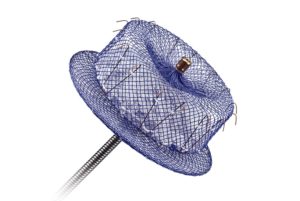
Latest data from the Amulet investigational device exemption (IDE) trial, comparing the Amplatzer Amulet (Abbott) left atrial appendage occluder (LAAO) to the first-generation Watchman 2.5 (Boston Scientific) in patients with non-valvular atrial fibrillation (AF) at increased risk of stroke, demonstrate similar clinical outcomes with the two devices out to five years.
Results of the trial were presented at the 2024 American Heart Association (AHA) Scientific Sessions (16–18 November, Chicago, USA) by the trial’s principal investigator, Dhanunjaya Lakkireddy (Kansas City Heart Rhythm Institute at HCA Midwest Health, Kansas City, USA), and published in the Journal of the American College of Cardiology (JACC).
LAAO works by preventing blood from entering the left atrial appendage, a pouch-like sac connected to the left atrium, to prevent blood clot formation and theoretically reduce the risk of stroke. Abbott’s Amulet device features dual-seal technology—a lobe to fill the body of the LAA and a disc to close off the opening into the LAA—which, according to the device manufacturer, offers immediate closure of the LAA, reducing the risk of stroke and immediately eliminating the need for anticoagulation post-implant.
To assess the safety and efficacy of the device, investigators in the trial enrolled 1,878 patients at sites internationally, with device implants attempted in 917 patients for the Amulet, and 916 for Watchman.
Three-year findings from the Amulet IDE were reported at the 2022 Transcatheter Cardiovascular Therapeutics (TCT) meeting, where Lakkireddy reported that more patients receiving Watchman (7%) were placed on oral anticoagulation than those receiving Amulet (4%), whilst rates of cardiovascular death (6.6% vs. 8.5%) and all-cause death (14.6% vs. 17.9%) trended lower with Amulet than Watchman, while stroke and major bleeding where comparable between the two groups.
At five years, Lakkireddy detailed that clinical outcomes were similar between the Amulet and Watchman devices, including the composite of ischaemic stroke or systemic embolism (7.4% vs 7.1), the composite of stroke, systemic embolism, or cardiovascular death (20.3% vs 20.7%), major bleeding (20.1% vs 20%), cardiovascular death (14.3% vs 15.4%), and all-cause death (28.7% vs 31.1%.
Annualised ischaemic stroke rates at five years were low and the same for Amulet (1.6%/year) and Watchman (1.6%/year) devices, the study investigators have found.
Additionally, they report that stroke in patients with the Amulet occluder were less severe (38 non-disabling, 11 disabling,11 fatal, 12 unknown) than stroke in patients with the Watchman device (19 non-disabling, 22 disabling, 17 fatal, 10 unknown).

Device-related thrombus or peri-device leak of 3mm or greater preceded stroke events and cardiovascular deaths more frequently in patients with the Watchman device (63) compared with patients with the Amulet occluder (31), the investigators found. A significantly higher percentage of patients were free of oral anticoagulation in the Amulet occluder group at each follow-up visit, with 94% and 90.9% free of oral anticoagulation at the last five-year follow-up visit in the Amulet and Watchman device groups, respectively, the investigators report in their JACC paper.
“Because blood thinners may cause excessive bleeding and side effects like nausea or dizziness, we as physicians want to avoid these medications for our patients following an LAA closure procedure,” Lakkireddy was quoted as saying in a press release issued by Abbott. “With the five-year findings from Abbott’s Amulet IDE study, doctors can even more confidently offer AF patients the minimally invasive Amulet device that not only closes the LAA and reduces their risk of stroke, but can also keep them off blood-thinning medication long term.”
The five-year results from the Amulet IDE study provide “important information that informs the field of LAAO broadly and helps to guide clinical decision-making” Daniel Friedman (Duke University Hospital, Durham, USA) and James Freeman (Yale School of Medicine, New Haven, USA) in an editorial comment accompanying the paper in JACC.
The comparable performance of the two devices in rates of stroke, embolism, cardiovascular death and all-cause death demonstrate the “remarkable consistency” in the effectiveness of percutaneous LAAO.
Of note, they highlight that although there was nearly four times more use of post-implant oral anticoagulation with Watchman, the annualised rate of major bleeding for the first six months was numerically lower with Watchman compared to Amulet (18.7% vs. 22.2%). For both arms, the annualised rate of major bleeding dropped precipitously after the transition to aspirin monotherapy (3.8% with Amulet, 4% with Watchman).
“These findings emphasise the importance of de-escalation antithrombotics to optimise the net clinical benefit of LAAO and challenge the dogma that dual antiplatelet therapy (DAPT) is associated with lower risk of bleeding than oral anticoagulation which has previously been called into question by a large registry analysis.”
The Amplatzer Amulet LAA occluder has been approved for use in countries in Europe, the USA, Canada and Australia, since its initial CE mark approval in 2013 and US food and Drug Administration (FDA) approval in 2021.









